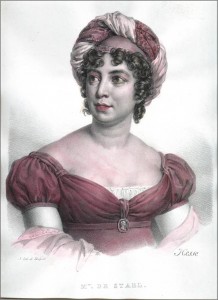Germaine de Staël – a woman whom Byron regarded as the most remarkable in Europe: a brilliant writer little read in England: a woman of soaring abilities and ambition, unlucky in love, hugely influential in European politics at a crucial period; rescuer of many a victim of the French Revolution; adversary of Napoleon; exile, mistress and wit. Germaine de Staël had everything except, perhaps, happiness. A Protestant and foreigner, she was mistrusted by many, especially those men and women who felt threatened by her brilliance.
Born to a brilliant Swiss finance minister Jacques Necker (1732-1804) who was in turn loved and hated by Louis XVI and the Revolution, Germaine was introduced into the highest levels of Parisian society. As a girl she met Voltaire and Walpole, might have married William Pitt, and instead found herself betrothed in a marriage of political convenience to the Swedish Ambassador to Paris, Eric Magnus Staël. He was a cold, stiff man whose chief interests in Germaine were her connections and her father’s fortune.
Germaine’s response to marriage was a succession of lovers. Her response to the French Revolution was to attempt to foster compromise. She tried to arrange Louis XVI’s escape from Paris; the new revolutionary constitution was written in her house. She wrote influentially on history and politics, on Rousseau and on suicide (her intense, over-pushy mother bequeathed her a strong sense of morbidity); she was exiled to her chateau at Coppet in Switzerland by Robespierre and by Napoleon, who detested her open attacks on him. She travelled widely, met everyone of importance in a continent at war, and lived long enough to see the restoration of the Bourbon monarchy.
Scientific progress makes moral progress a necessity; for if man’s power is increased, the checks that restrain him from abusing it must be strengthened.
Germaine de Staël
I have never known a woman who was more continuously exacting…. Everybody’s entire existence, every hour, every minute for years on end, must be at her disposition, or else there is an explosion like all thunderstorms and earthquakes put together.
Benjamin Constant (her long-time lover)
Staël is a genius, an extraordinary eccentric woman in everything she says or does. She sleeps only a few hours, and for the rest of the time she is uninterruptedly and fearfully busy…. Whilst her hair is being done, while she breakfasts, in fact for a third of the day, she writes. She has not sufficient quiet to look over what she has written.
An English doctor, meeting her at Juniper Hall, Surrey
The sciences have always owed their origin to some great spirit. [Adam] Smith created political economy; Linnaeus, botany; Lavoisier, chemistry; and Madame de Staël has, in like manner, created the art of analysing the spirit of nations and the springs which move them.
Obituary, Edinburgh Review 1818
Nature and Society have disinherited one half of mankind; strength, courage, genius, independence, all belongs to men: the laws of morality itself, according to the opinion of an unjust society, seem suspended in the relations between men and women; .. they [men] can have received from a woman the favours, the tokens of devotion which would bind together two masculine friends, two companions in arms and which would dishonour one of them if he were to prove capable of forgetting these; [yet] they have received the same from a woman, and extricate themselves from everything..
Germaine de Staël, On the influence of the passions
Germaine de Staël Timeline
1766 Born in Paris to Jacques Necker and Suzanne Curchod
1776 American Declaration of Independence
1777 Necker becomes Directeur-general des Finances under Louis VXI
1783 End of the American War of Independence, part-financed by France
1786 Germaine marries Eric Magnus Staël von Holstein after lengthy negotiations
1788 G. has affairs with Talleyrand and the Comte de Narbonne; writes on Rousseau
1789 Calling of Estates-General; Necker exiled and recalled; fall of Bastille
1790 G has a son by Narbonne. Publishes Sophie and Jane Grey.
1791 Germaine’s Paris Salon at the Swedish Embassy becomes famous
1792 The Terrors in Paris. MW publishes Vindication of the Rights of Woman;
G. brought before Robespierre; helps friends escape; fall of Comte de Narbonne
1793 Execution of Louis XVI; G meets Fanny Burney etc at Juniper Hall in England
1794 G Meets Benjamin Constant; writes Reflections on Peace; fall of Robespierre
1795 G sets up Salon with Constant; Abortive Royalist coup; G forced to leave Paris
1796 G. exiled at Chateau Coppet by Directory; writes On the Influence of Passions
1797 G. Meets Napoleon Bonaparte; Battles of Cape St Vincent and Camperdown;
mutinies at Spithead and the Nore; Godwin and Wollstonecraft marry; MW dies
1798 Battle of the Nile; Bonaparte stranded in Egypt
1799 Bonaparte stages Coup in Paris; Constant becomes Tribune; G: On literature
1802 Peace of Amiens; Bonaparte Consul for Life; exiles G. to Coppet
1803 Renewal of the War; G. exiled and travelling in Germany; meets Goethe etc
1804 Napoleon self-declared Emperor; G. travels in Italy then at Coppet
1805 G. begins Corinne; battles of Trafalgar and Austerlitz
1807 G. publishes Corinne; Treaty of Tilsit: Bonaparte and Alexander I of Russia
1808 Bonaparte invades Spain; G. begins On Germany; Constant marries
1810 On Germany is published and pulped by Bonaparte; G. meets John Rocca
1812 G, is in Moscow before Bonaparte gets there to find it burning; Retreat from
Moscow; Anglo-American War until 1814; Congress of Vienna
1813 G. published On Suicide; meets Byron, Samuel Taylor Coleridge and
Wilberforce in England; Austen: Pride and Prejudice; Shelley: Queen Mab
1814 Invasion of France; Bonaparte abdicates. G, returns to Paris; meets Duke of W
1815 The 100 Days; Waterloo; G. leaves Paris for Coppet and returns after June
1816 G, receives Byron at Coppet; marries John Rocca
1817 G. dies in Paris.
1818 Considerations on the Principal events of the French Revolution published
1820 Complete Works published

